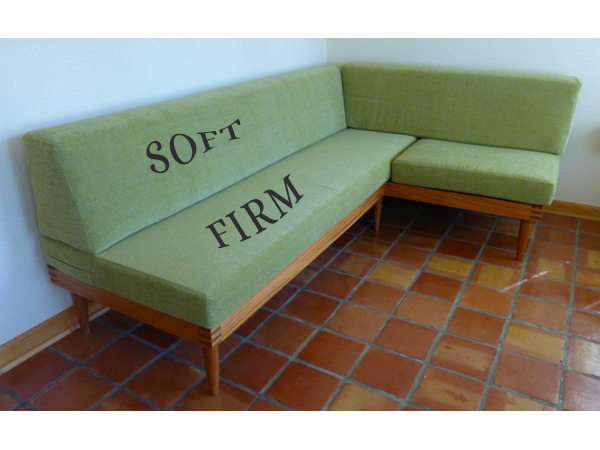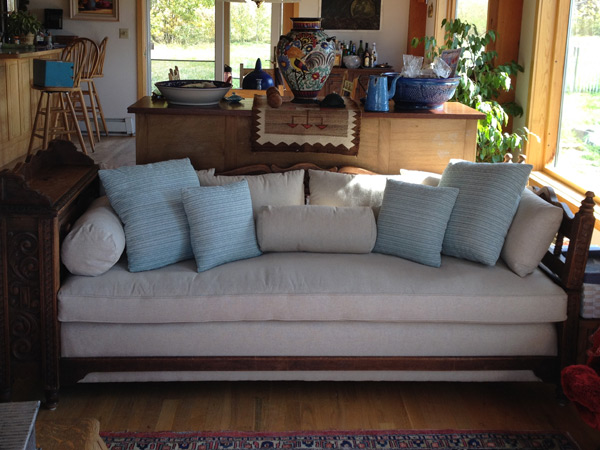How to Choose

As a rule, back cushions are soft, and seat cushions are firm
Natural latex foam for upholstery: Learn the four factors that affect your choice of upholstery foam for sofa cushions or ‘tight’ upholstery (attached directly to the underlying frame or seat foundation). First, let’s look at the terms:
Firmness & Density – defined
It’s important to make the distinction between firmness & density, which are the two verifiable, scientific measurements used to rate the feel and quality of ALL foams, including natural latex.
FIRMNESS = Comfort (measured as pressure to compress a given thickness by a given amount)
- interprets the feel of foam and how it yields to weight and pressure
- is designated by the term ‘Indentation Load Deflection’, or ILD (also known as ‘Indentation Force Deflection’, or IFD), determined by mechanical performance testing in which a standardized foam sample is used to measure the force in pounds that it takes a 50 square inch circular indenter to compress the material by 25 percent of its thickness
- a very firm foam material will require greater force to reach the same compression as a softer material, and thus will have a higher ILD rating
- Note: ILD is only accurate when comparing the same type of latex from the same latex manufacturer. For our purposes, we are talking about 100% Natural Dunlop Latex.
DENSITY = Weight (measured as weight of a given volume of material)
- Density is a measurement of the mass per unit of volume – for latex expressed as kilograms/cubic meter (converted to lbs/cubic foot to remain consistent with units of measurement familiar to the U.S. upholstery industry)
- Density in natural dunlop latex usually varies from around 60 kg/m3 to about 95 kg/m3 (4.4 lb/ft3 – 5.9 lb/ft3)
- If a latex foam has a density rating of 95D, that means a 1 meter x 1 meter x 1 meter block weighs 95 kilograms (or a 1 foot x 1 foot x 1 foot block weighs 5.9 pounds).

Antique carved oak daybed with natural and organic upholstery
Firmness, ILD ratings & Densities for 100% Natural Dunlop Latex Foam:
- soft (16-18 ILD) – Density: 65 kg/cubic meter (4.1 lbs/cubic foot) – N25
- medium (23-27 ILD) – Density: 75 kg/cubic meter (4.7 lbs/cubic foot) – N28
- firm (28-33 ILD) – Density: 80-85 kg/cubic meter (5.0 lbs/cubic foot) – N31
- x-firm (34-48 ILD) – Density: 90-95 kg/cubic meter (5.6 lbs/cubic foot) – N36
- hard (39-43 ILD) – Density: 95+ kg/cubic meter (5.9 lbs/cubic foot) – N45
Firmness is Subjective
If you’re doing your own upholstery project, such as replacing a sofa cushion, re-covering your dining chairs with new foam, or building a new window seat cushion, keep in mind that different foam firmnesses are recommended for different purposes.
The comfort of any cushion depends on these FOUR VARIABLES:
- Your preference (do you like to sink into your furniture, or feel more supported?)
- Your weight (more weight requires higher density / firmness)
- The designated use (seat or back cushion on a sofa, window seat, etc)
- Thickness of the cushion (a thicker foam with the same ILD rating feels firmer)

General recommendations for Latex Foam firmness
For a 5-6” thick seat cushion, the most popular firmness is 31-35 ILD (firm); 26-30 ILD (medium) feels soft – for those who like to sink into the sofa; for those who prefer a firmer seat cushion with plenty of support, 36-42 ILD (extra-firm) is a good choice for this thickness.
The thinner the foam, the less support it gives per unit of body weight, so the higher the firmness (ILD) you need. For example, if you’re buying 1-2 inch thick foam for a dining chair seat, it won’t take much weight to ‘bottom out’ with this thin application, so you’ll want to order the firmest foam to achieve the greatest comfort.
A sofa or chair back cushion should be softer because ‘leaning on’ exerts less pressure than ‘sitting on’. For a 4” thick back cushion, the most popular firmness is 17-25 ILD (soft); choose 26-30 ILD (medium) for thinner back cushions or for a firmer feel.
Learn more about choosing the right foam for your upholstery project:
Download our FREE Guide to Natural Latex Foam Firmness & Density, to get natural latex upholstery foam firmness recommendations for different thickness applications, based on a specific body weight. Watch the video here: ‘How to Choose Natural Latex Foam Firmness for Your Upholstery Project’.
Are you a maker, designer or upholstery professional?
Join our mailing list to learn more and get up-to-date resources for natural upholstery materials.

Thank you for the nice information
If density and ILD are independent, why in the above listing do they seem to be directly related?
Should I not be able to get a very high density (85-90) foam with a lower ILD for softness? I would think I should be able to get a medium ILD (26-30) in a high density (85-90). In that way, I’d get highest quality foam in a softer comfort level. What am I missing?
Higher density = Better quality = Longer lasting
Hi Christopher,
Thank you for pointing this out. This is a confusing subject with many facets, but as you have suggested, firmness and density ARE directly related, so for your example, you would not be able to get a soft firmness (ILD) in a 85-90 density foam. I have edited the post to eliminate this confusion. I hope it is more understandable now.
Carla
Hi Carla !
I see that your last post was on the 20th of Nov 2017 so I hope this page is still “live” because I really appreciate the time you have taken to provide information on what is a confusing subject. May I suggest that you perhaps re-write the paragraph under “General recommendations for Latex Foam Firmness” so that each category is clearly defined in a single sentence… As that paragraph is presently constructed it is somewhat confusing when trying to determine the appropriate firmness that is required to resolve my issue… I fell a month ago onto concrete dividers in a nearby parking lot while it was very dark and unfortunately fractured my left shoulder, left arm and one of my ribs. Several days after the accident I tried to lie down in bed but after a short rest I tried to get out of bed. That’s when i realized i would be confined to a leather easy chair in our family room until I was fully recovered. As you can understand, although I am using pillows on top of the leather, it isn’t very long during the day that my derriere tells me that it’s time to get up and take a stroll around the house! If I can find a thick cushion, perhaps 5″-6″ like the one you have mentioned, I presume you would suggest a firmness of 31-35 ILD. Please confirm that my understanding of your guidelines is correct; and if you could suggest where i might be able to find a cushion meeting this criteria i would be grateful. I would need a cushion measuring 18″x20″, and preferably at least 4″ thick. Thanks again for the time and effort you have put into this valuable service. Monte
Hi Monte,
I’m so sorry to hear about your injuries – I hope you are on the mend despite the challenges. Recommending latex foam firmness is a tough call because the judgement is subjective, especially where an injury is involved. I always recommend trying out a sample to make the determination for yourself. That said, my personal (subjective) experience would think that a latex firmness of 31-35 ILD is going to feel quite firm. If I were in your circumstances, I might try the 21-28 ILD. Check out ‘Where to Buy Natural Upholstery Materials’ for a list of vendors who sell natural latex foam and other non-toxic materials. Thank you for your suggestions on how I might improve this page – I will take your advice into consideration on my next edit.
Carla
Like previous commenters, I’d like to express my appreciation for your providing this information, which has been the most understandable yet succint explanation of this subject I’ve found. Helpful!